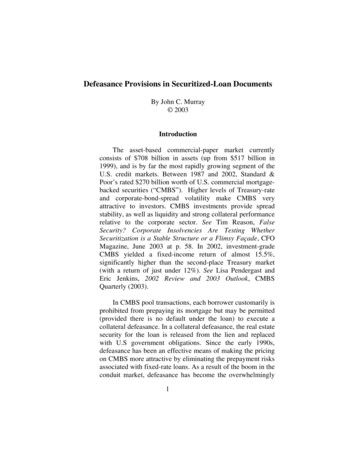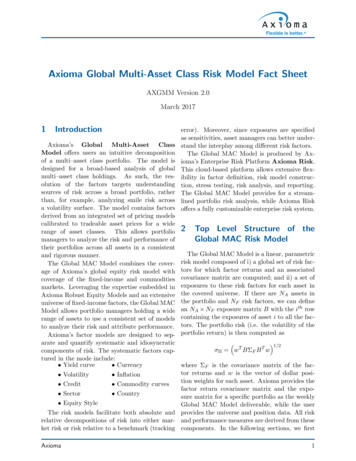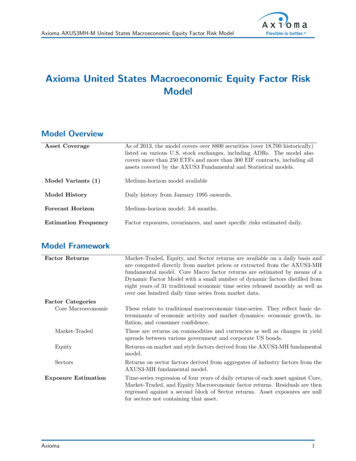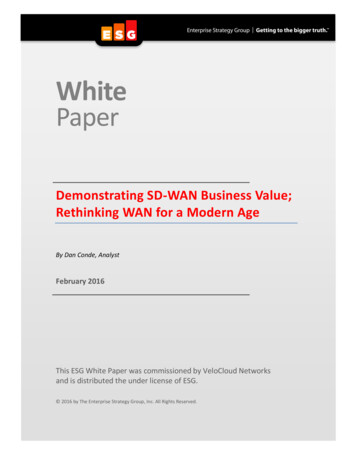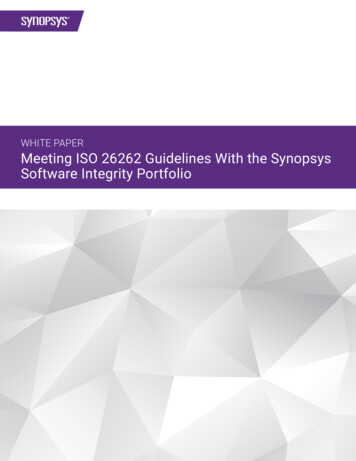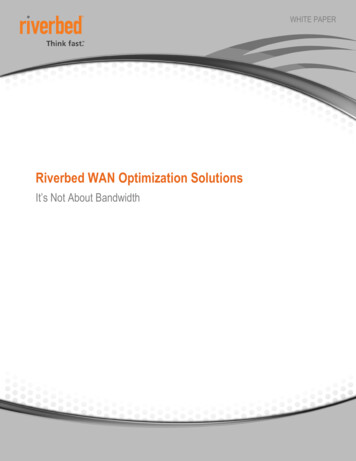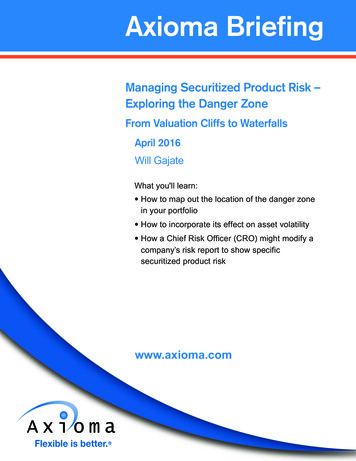
Transcription
Axioma BriefingManaging Securitized Product Risk –Exploring the Danger ZoneFrom Valuation Cliffs to WaterfallsApril 2016Will GajateWhat you'll learn: How to map out the location of the danger zonein your portfolio How to incorporate its effect on asset volatility How a Chief Risk Officer (CRO) might modify acompany’s risk report to show specificsecuritized product riskwww.axioma.com
Securitized Products: An Unexpected Risk Management ChallengeAlmost ten years after the subprime crisis, securitized assets still pose risk management problemsfor fixed income portfoliosMany asset managers and hedge funds with exposure to U.S. fixed income are caught unprepared bythe risk management challenges that securitized products pose. Not only do funds tend tounderestimate their exposure, but they also find the risk associated with these assets particularly hardto model. Many of the risk management systems that failed investment firms in 2008 are still in use,and continue to be ill-equipped to rise to the challenge of managing securitized asset risk.In this whitepaper, we will explore how to discover the hidden risks associated with securitizedproducts. We will work through a specific example of a typical model pipeline for valuing securitizedproducts and share a case study of a CRO tasked with vetting a fixed income relative value strategyand compiling a risk report that clearly shows securitized product risk. We will also introduce some ofthe tools that Axioma can provide to buy-side firms to meet this challenge.Table of ContentsSecuritized Products: An Unexpected Risk Management Challenge . 1Securitization Danger Zone: From Cliffs to Waterfalls . 2Understand the Danger Zone: The Waterfall .2Reveal the Danger Zone: The Valuation Cliff .3How to value ABS tranches and manage their risk . 3Risk Management Case Study . 4Step 1: Identify Risk Factors .4Step 2: Review the Portfolio .5Step 3: Map the Danger Zones .5Risk Reporting.6
Managing Securitized Product Risk - Exploring the Danger ZoneAn Axioma Multi-Asset Class Risk WhitepaperSecuritization Danger Zone: From Cliffs to WaterfallsSecuritized products are associated with a heavy data burden: The municipal sector, for example, hasone of the most complex data sets, as there are about 50,000 municipalities - each with its own flavorof debt features. Credit default swaps, interest rate and FX derivatives, on the other hand, requirehighly sophisticated modeling andanalytics.Securitized assets pose a particularchallenge as they combine complexmodeling and data prerequisites. If just oneof those elements is lacking in quality, riskmanagement outcomes become veryuncertain. And there are a staggeringnumber of investable securitized assets:about 1.2 million, cutting across loan types and geographic regions.Securitized assets come in the form of notes - also called tranches - that have a nice cohesiveappearance. They provide simple access to the underlying loan pool, tailored to the investment risktolerance of different types of investors. This enables investors to select tranches with a specific term,coupon expected average life, and rating, making it easier for investors to categorize and explain themto their stakeholders.Yet the description of the notes in the prospectus is likely to leave institutional investors unaware oftheir danger zone, which is located in the embedded options or outcomes of the loans backing thetranches. As the investor is now once removed from the loans, they may not have a full understandingof the interest rate or credit exposures associated with the collateral.These embedded options are very difficult to model and evaluate. For example, residential mortgagesusually have three outcomes: To be repaid over the term of the loan, to be repaid before its full term,or a strategic or involuntary default - in which case the lender gains the right to sell the asset to recoverthe loan. The default value can be driven by unemployment while recovery value can be driven fromhome price appreciation at time of default.Understand the Danger Zone: The WaterfallInstitutional investors should aim to understand an important factor that can magnify their exposureto these embedded options: the waterfall. Asset-backed securities (ABS) typically have a waterfallstructure for payments – after higher-tiered creditors receive interest and principal payments,cashflow is then allocated to the investors in the various tranches of the ABS according to the priorityrules set out in the prospectus.These waterfall cashflow allocation rules protect senior holders against losses or unexpectedprepayments, but they can also dampen and amplify tranche exposure to the loan pool’s embeddedinterest rate/credit options.It could be argued that as these rules are determined up-front at note issuance, there should be noshocks when it comes to allocating flows. However, there can be surprises in store for investors in theform of errors in forecasted losses and prepayment rates on the collateral that was used to initiallyvalue the notes.2
Managing Securitized Product Risk - Exploring the Danger ZoneAn Axioma Multi-Asset Class Risk WhitepaperReveal the Danger Zone: The Valuation CliffA major aspect of the danger zone facing investors in securitized products is the valuation cliff,which is caused by combining the waterfall effect with embedded options.Understanding how credit support operates is central to understanding the valuation cliff inherent insecuritized assets. Notes are split into three tranches:1. Seniors: The senior tranche is sized at issuance so that it can withstand up to 6x expected losses2. Mezzanine3. SubordinatesThe exact support levels are determined by the rating agency engaged for the transaction. Thevaluations of these tranches have regions of sharp curvature due to embedded interest rate/creditoptions on the collateral and the impact of special purpose vehicle (SPV) allocation rules.How to value ABS tranches and manage their riskIf a risk manager evaluating the risks of securitized assetshas access to a risk system that can model the exposure ofthese embedded options to market risk factors such asfinancing rates, and macro-economic fundamentalvariables like GDP growth, home price appreciation andchanges in regional unemployment rates, then they willhave the ability to map out tranche valuation at each levelof the risk factor.The risk manager might start with 10-year swap rates attoday’s level, push them up by 25 basis points, revalue thetranche and repeat going up and down along the axis ofthe risk factor.If the risk system is really modeling the embedded options,the risk manager will see a range of values for the riskfactor, with the optionality causing a signature S-curveshape.However, if this calculation does not reveal a valuation cliffhiding in the tails of the risk factor distribution, then it islikely that a key exposure for residential mortgage-relatedassets, extension risk, is missing. Extension risk occurswhen existing collateral pools tend to repay more slowlythan expected. It is an undesirable outcome for trancheholders who are hoping to capture the higher fixed incomecoupons or floating spreads that accompany rising interestrate environments.Did you know? Axioma offersspecialized stress tests andpricing models for securitizedassets. With Axioma Risk, riskmanagers can shock theirsecuritized assets and determinethe specific risks inherent in theirexposure to this asset class.Axioma Risk stress tests enableyou to: Stress any factor Choose from and customize awide variety of preconfiguredhistorical stress tests Conduct transitive stress tests,which forecast the impact of ashifted factor on other factors,even those that seem unrelatedto the shifted factorIt is difficult to build a tranche valuation system that takes into account both the embedded optionalityof the collateral and the impact of the waterfall rules, but it’s not impossible. A lot of analytical powerand flexibility as well as data are required to get this far for institutional-sized portfolios.3
Managing Securitized Product Risk - Exploring the Danger ZoneAn Axioma Multi-Asset Class Risk WhitepaperIn order to capture the embedded optionality and credit subordination of the waterfall structure, therisk manager needs a pipeline of models to evaluate the different tranches. Axioma does this bydrawing on tools from the world of interest rate derivatives to put together a risk-neutral termstructure model, which enables us to forecast long-term financing rates.In addition, it’s necessary to forecast fundamental macro-economic credit variables, like GDP, homeprice appreciation and unemployment rates, as these are the risk factors that drive the value of thecredit options embedded in the collateral backing the tranches.Once the risk manager can model forward-looking macro-economic expectations, they can layer inthe collateral response to those factors and treat the optionality directly.Then they still have to run the projected collateral cashflows to project tranche level cashflows anddiscount them back to the analysis date. They would use a risk-neutral discount factor to finally arriveat the present value of the tranche.In the context of the commonly used Monte-Carlo valuation function, this means simulating economicvariables and long-term financing rates many times and taking the average of all the simulated tranchevalues to obtain the Monte-Carlo estimate of tranche value.Risk Management Case StudyThe new CRO of Incognito Asset Management inherits a pending project from her predecessor: As oneof her first tasks, she is to vet a fixed income relative value strategy.The strategic mandate of the portfolio is to outperform the Barclays Aggregate by picking higheryielding bonds in the securitized sector with similar or matching exposure to the benchmark.As with any benchmarked strategy, a key constraint is that the portfolio manager’s portfolio volatilitycannot exceed benchmark volatility by more than 30bps.The CRO has to examine this portfolio and see if it aligns with the strategic mandate. She also needsto have a risk report ready to discuss with the portfolio manager tomorrow.The portfolio has three positions: one senior tranche of a non-agency deal, one corporate position,and one treasury position.Step 1: Identify Risk FactorsThe CRO identifies four core risk factors:1.2.3.4.Interest RateSecuritized MBSSecuritized (Non-Agency)Corporate (IG) SpreadsThe CRO now contemplates how to capture all important risk factors and exposures in the risk report.To determine this, she decides to have a closer look at the portfolio.4
Managing Securitized Product Risk - Exploring the Danger ZoneAn Axioma Multi-Asset Class Risk WhitepaperStep 2: Review the PortfolioThe CRO finds that portfolio manager has picked the‘cheapest’ securitized bonds possible while remainingwithin the prescribed range of portfolio volatility.As the sector weights are all fixed at the benchmarkweighting, the portfolio manager has simply replacedthe agency MBS exposure (present in the benchmark)with exposure to the senior tranche of a non-agencydeal.The CRO then identifies that while most of the expected return is coming from the securitized sector,most of the portfolio volatility comes from the corporate sector. If the portfolio manager had selectedhigh-yield bonds, this pattern would not be unusual, but it can also be a first clue as to what’s missing:Higher yield bonds should dominate risk when the portfolio manager picks the lowest price for thehighest yield. The CRO is therefore now asking herself if the portfolio manager is really identifyingbargains or if the risk analysis is in fact missing a source of risk.Step 3: Map the Danger ZonesThe next thing the CRO does is to locate the presence of a valuation cliff with respect to expectedcollateral losses. She maps out the valuation cliff by stressing collateral losses from base expectedlosses to 6x base.As Incognito Asset Management implementedAxioma Risk last year, the risk system enablesthe CRO to construct stress test scenarios withcollateral losses that can be increased by amultiple of the base loss forecast on thecollateral of the senior tranche.The CRO then revalues the tranche at thestressed collateral losses to identify thevaluation cliff.Next, the CRO needs to capture the impact of macro-economic variables such as GDP andunemployment, as these factors are a source of volatility and drive the value of the embedded creditoptions.Instead of relying on decomposition of market risk along macro-economic variables, she uses thestandard deviation of historical losses on collateral, assumes historical correlation with interest ratesand chooses to compute tranche sensitivity with respect to changes in collateral losses. This isanalogous to effective duration, which is the price sensitivity with respect to a yield curve shift.She understands the asymmetry of the pricing function and chooses to use a one-sided shift at 3x baseexpected losses. Now all that remains to do is to connect this tranche sensitivity with an estimate ofvolatility of collateral losses, and she has now captured the risk factor driving the value of theembedded credit options.5
Managing Securitized Product Risk - Exploring the Danger ZoneAn Axioma Multi-Asset Class Risk WhitepaperRisk ReportingFinally, the CRO shows the portfolio manager that tranche exposure to collateral losses raises portfoliovolatility beyond the bounds imposed by the strategic objectives. This is the modified risk report withthe inclusion of the collateral loss exposures:Our CRO discusses the report with the portfoliomanager and other stakeholders and explainsthe contribution non-agency seniors to portfoliovolatility. As a result, the fund managers decideto incorporate this type of risk in their marketingmaterials. They also consider using this new riskfactor as part of the selection criteria forimplementing a relative value strategy.Find out more - See the Future of Securitized Asset ModelingMany CROs regard a risk system that can decompose securitized asset volatility along the coredrivers of the embedded options as the 'holy grail' of securitized products risk management.Contact Axioma today to find out how we are working to give CROs and portfolio managers a clearview into asset-level exposure to macro-economic factors and financing rates.6
to model. Many of the risk management systems that failed investment firms in 2008 are still in use, and continue to be ill-equipped to rise to the challenge of managing securitized asset risk. In this whitepaper, we will explore how to discover the hidden risks associated with securitized . Axioma Risk
